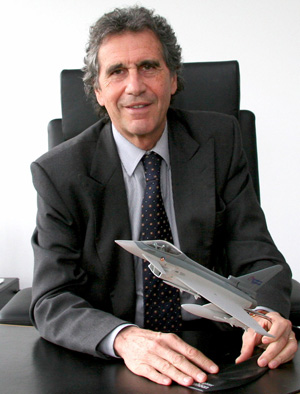The four-nation Eurofighter consortium is within weeks of submitting its response to Germany, Italy, Spain and the UK on a package of capability enhancements which could prove pivotal to its success in winning future international deals with the combat aircraft.
Almost 340 Eurofighters have been delivered so far to the programme's launch partners, plus export customers Austria and Saudi Arabia, and the type saw its first combat use in 2011, over Libya.
Following a lengthy period of promotion by suppliers, including EADS defence arm Cassidian, a proposal to add new equipment to boost the type's multi-role credentials finally gained traction at the Farnborough air show in July.
To go beyond a Phase 1 Enhancement programme (P1E) already under way, the work will introduce the ability for the Eurofighter to carry new weapons and sensors, with the latter to ultimately include an active electronically scanned array (AESA) radar; a piece of technology increasingly mandated by potential buyers.
"At present, we are finalising our response to NETMA [the NATO Eurofighter and Tornado Management Agency] and the nations," says Eurofighter chief executive Enzo Casolini. "In July, we received the request for quotation and we will answer by the end of October with the target to possibly sign a contract by mid-2013."
Developed from the common requirements of the partner air forces, the multi-phase process will start with an initial release of P1E(a) capability late this year, with full capability for P1E(b) following by the end of 2013.
 |
|---|
| Enzo Casolini outlines priorities |
"The further enhancement programme phases are based on a common programme strategy, which includes core customers' and export customers' requirements," Casolini explains. "The most important element of the work is delivering the planned E-Scan capabilities through a common integrated development and implementation programme, whilst enabling cost-effective tailoring to meet specific national operational requirements." The AESA array should be ready for operational use around 2015.
Defeat in India's medium multi-role combat aircraft (MMRCA) contest by the Dassault Rafale in January was one factor which contributed to the P1E decision, as a Cassidian-led Eurofighter Typhoon bid had been strongly favoured to land the 126-unit deal. Discussions continue between New Delhi and the French supplier over a contract.
"We have great respect for the professionalism of the Indian government and the Indian air force in how they conducted the technical MMRCA evaluation," Casolini says. "However, we still believe that a clarification of our commercial offer would convince the Indian customer of a greater commercial attractiveness of the Eurofighter offer.
"Cassidian, BAE Systems and Alenia Aermacchi, alongside the four governments, stand ready to engage in case we should be invited by the Indian government. So far, nothing has been signed. Therefore the deal is not yet done."
As a result, Eurofighter will participate in the Aero India event in Bengaluru in February. "It is an excellent air show, and it will be an opportunity for us to maintain our presence in the country," Casolini says.
"Competition on the global market is very tough, but we are confident that we can clock-in a few more contracts and customers because we have an excellent product," he notes.
Eurofighter now has sales campaigns running in nations including Bulgaria, Kuwait, Malaysia, Qatar, Romania, South Korea and the United Arab Emirates, while the UK is also close to finalising a government-to-government deal to supply 12 Typhoons to Oman.
"The worldwide market potential for next-generation combat aircraft is approximately 800 aircraft in the next 20 years, and we expect to gain about 25% market share."
Describing the Typhoon as "a powerful and reliable swing-role combat aircraft", he adds: "Eurofighter is proven in global operations and international co-development and trusted to deliver performance as well as political and industrial partnership."
With budgets tight among its home customers, earlier this year Eurofighter agreed to reduce its high delivery rate for the type through its completion of 112 Tranche 3A production examples.
Asked whether he believes Germany, Italy, Spain and the UK will follow this with an originally planned Tranche 3B deal under a background of tight fiscal constraints, Casolini says the consortium has time on its side.
"Current production of the Eurofighter is secured until the end of 2017, and the deadline to the Tranche 3B contract signing has been moved to December 2013 thanks to the slowdown. Any speculations before that deadline would be inappropriate," he adds.
Check out our complete coverage for the ILA Airshow
Source: Flight Daily News



















